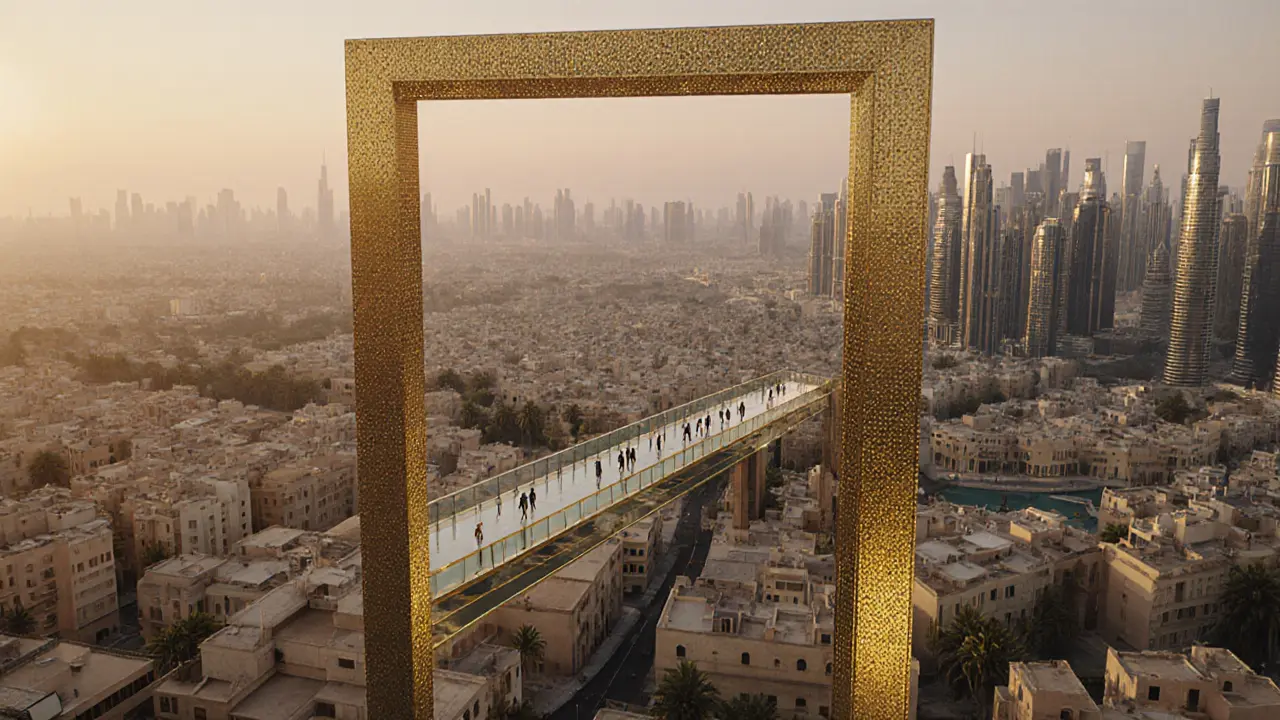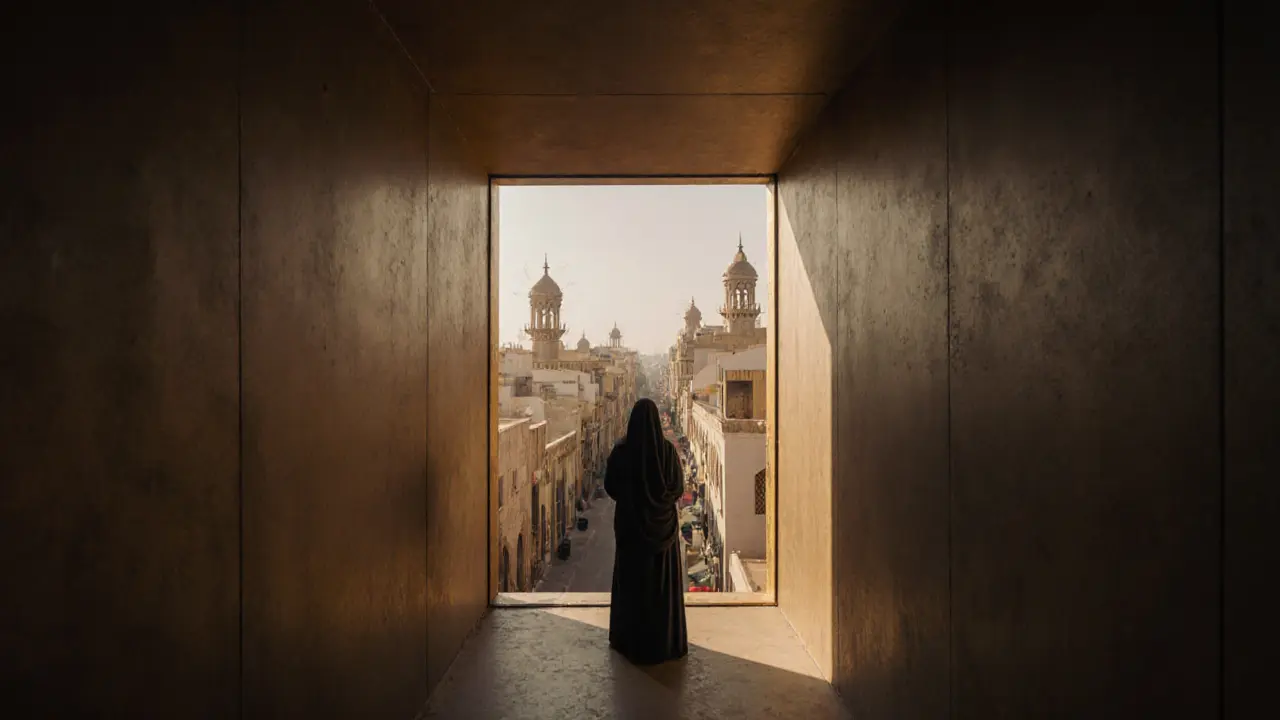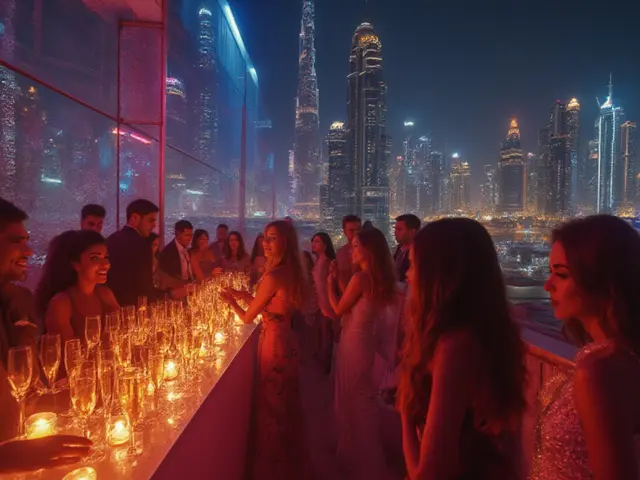
The Dubai Frame isn’t just another tall structure in the city-it’s a walking museum, a photo op, and a symbolic bridge between old and new Dubai. Most visitors snap a picture at the glass floor and move on. But there’s so much more beneath the surface. Here are 10 facts about the Dubai Frame that even seasoned travelers rarely hear.
It’s the world’s largest picture frame
At 150 meters tall and 93 meters wide, the Dubai Frame holds the official Guinness World Record for the largest picture frame. That’s bigger than the Eiffel Tower’s base and wider than a football field. The frame isn’t decorative-it’s functional. It literally frames two distinct sides of Dubai: the historic neighborhoods of Old Dubai to the north and the futuristic skyline of New Dubai to the south. When you stand inside, you’re not just looking at a view-you’re seeing the city’s transformation through a literal lens.
The frame’s gold cladding isn’t paint-it’s real gold
The entire exterior is covered in 2,000 square meters of gold-colored stainless steel panels, each coated with a thin layer of real gold leaf. The gold isn’t just for show. It reflects the desert sun so intensely that the structure glows like a beacon during midday. Engineers chose gold for its durability and heat resistance. Unlike paint, it won’t peel or fade under Dubai’s 50°C summers. The material cost alone was over $12 million.
It was designed by a Mexican architect
Most people assume the Dubai Frame was created by a local or European firm. But the winning design came from Fernando Donis, a Mexican architect based in Shanghai. His concept won a global competition in 2008, beating out over 150 entries from 37 countries. Donis didn’t just want a landmark-he wanted a narrative device. His idea was to make visitors feel like they were stepping through time. The design was finalized in 2011, but construction delays pushed the opening to 2018.
The glass floor is made of 200mm-thick tempered glass
Walking across the glass floor on the 150-meter-high bridge isn’t for the faint of heart. The glass is 20 centimeters thick-thicker than the floor of most high-rise apartments. It’s made of laminated tempered glass, the same kind used in skyscraper facades and aquarium tunnels. Each panel can support over 5,000 kilograms. The structure beneath it is a steel truss system designed to absorb movement. Even when 100 people walk across it at once, the sway is less than 2 millimeters.

It has a hidden observation deck you can’t see from the outside
Most tourists think the only view is from the glass bridge. But there’s a second, smaller observation deck tucked inside the frame’s north pillar. It’s accessible only through a narrow staircase and isn’t shown on most maps. From here, you get a direct, unobstructed view of the Al Fahidi Historical Neighborhood-something you can’t see from the main bridge. Locals call it the “secret window to the past.” It’s rarely crowded, and staff rarely mention it unless you ask.
The interior museum uses scent technology
The museum inside the Dubai Frame doesn’t just show you Dubai’s history-it makes you smell it. Using scent diffusion systems, the exhibit releases specific aromas at key moments: the smell of dried fish and sea salt in the old fishing district, the scent of oud and incense from traditional markets, and even the faint aroma of desert sand after rain. This multisensory approach was developed with input from neuroscientists at the University of Dubai. Studies showed visitors remembered 68% more details when scent was added to visual exhibits.
It was built over a former landfill
The land where the Dubai Frame stands was once a garbage dump. In the early 2000s, the area was used to dispose of construction waste from Dubai’s rapid expansion. Before construction could begin, engineers had to cap the landfill with a 5-meter layer of impermeable clay and install a methane gas extraction system. The frame’s foundation sits on 142 reinforced concrete piles driven 65 meters into the ground to avoid settling. Without this step, the structure would have tilted within a decade.

The elevator is one of the fastest in the Middle East
The vertical transit system inside the frame uses twin high-speed elevators that travel at 6 meters per second-faster than most hotel elevators in New York or London. The ride from ground level to the bridge takes just 28 seconds. The elevators are equipped with pressure sensors and LED panels that simulate a time-lapse of Dubai’s skyline during the ascent. The system was custom-built by a German manufacturer and required special permits because it exceeds standard safety limits for public buildings in the UAE.
It’s designed to be earthquake-resistant
Dubai isn’t on a major fault line, but the frame was built to withstand a magnitude 7.0 earthquake. That’s the same standard used for buildings in Tokyo and Los Angeles. The structure uses a base isolation system-steel dampers and rubber bearings between the foundation and the frame-that absorb seismic energy. During testing, engineers simulated quakes up to 7.5 magnitude. The frame moved less than 15 centimeters. It’s one of the few landmarks in the UAE built to this level of seismic safety.
The lighting system changes based on the weather
At night, the Dubai Frame glows with LED lights that shift color depending on temperature and humidity. On hot, dry days, it glows amber. During high humidity or rain, it turns blue. The system uses real-time weather data from Dubai’s meteorological department. It’s not just for aesthetics-it’s a public service. Tourists and locals use the color as a quick indicator of weather changes. On summer nights, when temperatures drop below 25°C, the frame turns green-a signal that it’s a good night to walk along the nearby park.
It’s more than a monument-it’s a time capsule
Beneath the museum floor, sealed in a climate-controlled vault, are 10,000 digital files from Dubai residents. Each file contains a photo, a voice recording, or a handwritten note about what life in Dubai meant to them in 2018. These were collected through a citywide campaign before the frame opened. The files won’t be opened until 2068-the 50th anniversary of the UAE’s founding. Future generations will be able to hear a taxi driver from Sharjah, a nurse from India, and a schoolgirl from Deira describe their lives. The frame isn’t just a symbol of the past and future-it’s a bridge to the people who lived through it.



